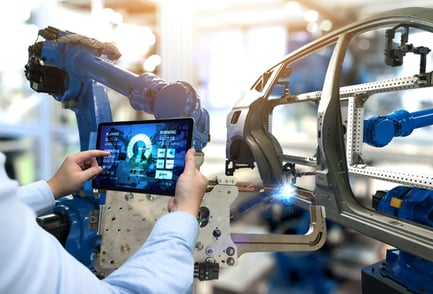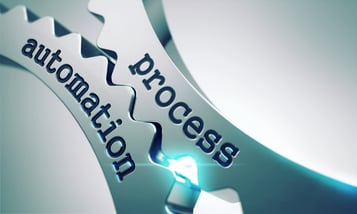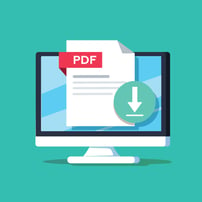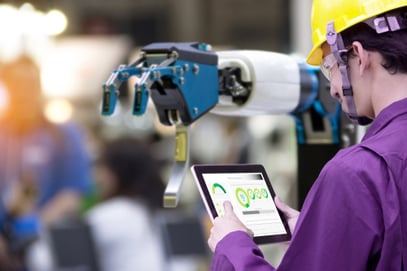Automation software and hardware advances reduce programming tasks and provide more built-in configurability, scalability, background communication among software components, simulation/digital twin capability, and usability. 
Today’s automation hardware and software can integrate much more than stand-alone machine controls. There is a need to provide an integrated development and programming environment that presents itself in an approachable, cohesive way.
It’s not enough to pick a programming language and go–that’s only viable for straightforward machine applications. Today, machine automation requirements integrate HTML5 human-machine interfaces (HMIs), input/output (I/O), sequential logic, motion and networked safety, robotic and collaborative robot kinematics, vision, safe robotics and motion, condition and energy monitoring, machine-to-machine communications, coordination with multiple production modules and intelligent track systems, edge and cloud communications, and interfaces.
Requirements span more than direct control capabilities. There is an increasing need to integrate reporting, database management, and machine simulation for initial design and ongoing optimization through digital-twin capabilities.
These capabilities require a holistic, ground-up approach to automation software platforms that is scalable, modular, documented, reusable, and based on the IEC 61131-3 programming languages standard. Today, automation technology companies provide a comprehensive range of capabilities including single- and multi-axis motion, computer numerical control (CNC), recipe and alarm functions, user management and audit trail, industry standards (such as PackML from OMAC Packaging Workgroup), and web diagnostics.
Many capabilities highlighted used to be available only as third-party software, but now are considered standard in many packages and are helping change automation implementations.
HMI animations
 Dynamic HMI content makes it easier to visualize complex manufacturing processes. One approach uses a widget to allow users to animate XML-based scalable vector graphics (SVG) images they already have or to convert them from 2-D CAD with runtime data.
Dynamic HMI content makes it easier to visualize complex manufacturing processes. One approach uses a widget to allow users to animate XML-based scalable vector graphics (SVG) images they already have or to convert them from 2-D CAD with runtime data.
The user drags and drops a widget onto the desired page in the HMI application and configures it there. At runtime, the image’s animation can be controlled from the application program. Rotations, transitions, and movements can be animated from one SVG image, which saves the time and cost needed to create sequences of multiple images. Also, since SVG images are based on vector graphics, they retain their high resolution without loss of quality even when zoomed in.
Managing machine variants
Modular applications can be implemented to add I/O modules to existing programs at any time without touching the machine code. This can happen before a machine is delivered or even at runtime, which simplifies managing machinery and equipment variants. I/O variant configurations can be generated from enterprise resource planning (ERP) or an order management system. No engineering tools are required even if third-party drives or modules are added.
Additional variants and options may be configured directly on the machine using the appropriate configuration tools. Some development environments include a tool that allows the programming of options in ladder logic without affecting the machine’s primary application. The machine can be commissioned without having to modify the original machine software, giving the end user needed flexibility while preserving the integrity of the original equipment manufacturer (OEM) solution.
Integrated vision
Another trend is integrating vision cameras into the machine control program, including intelligent cameras, lighting, and advanced image processing algorithms. This allows microsecond synchronization between the machine vision and other automation components with one engineering tool and one application to manage.
PDF reports
 Communication platforms can be built into the control system, and they automatically can generate PDF reports. Reporting functionalities collect statistical machine data and information from any software components provided by the control platform. The data, layout, and design of the reports can be customized and the user can define the language and units used.
Communication platforms can be built into the control system, and they automatically can generate PDF reports. Reporting functionalities collect statistical machine data and information from any software components provided by the control platform. The data, layout, and design of the reports can be customized and the user can define the language and units used.
Report design options make it possible to customize reports to the users’ needs. Graphical elements such as images and tables can be included in the reports. To protect against unauthorized access, it is possible to encrypt the files. The reports can be sent automatically via e-mail at a defined time or triggered by a specific event. In addition, reports can be saved to external storage media such as a USB flash drive or sent directly from the machine to network printers.
Data management
Implementing databases in applications is easier with a database integration toolbox. Data may be archived from the field level to a database, regardless of whether that database is located on-site or in the cloud. This simplifies managing large volumes of data, which is key to Industrial Internet of Things (IIoT) data acquisition and analytics requirements.
Manufacturing machinery can generate huge volumes of data, which must be visualized, archived, or passed on to higher-level systems for processing to be useful. Giving the control system a database interface makes it possible to send data directly from the controller to the database. Common database functions such as stored procedures allow key performance indicators (KPIs) to be generated as needed, resulting in more optimized manufacturing processes.
Machine simulation and digital twins
Automation programming is no longer limited to isolated machine programs. It now includes integrated production systems such as the next generation of intelligent track technologies that define the adaptive machine.
Consider the automation software challenge of independently controlling individual products traveling on shuttles in coordination with dozens or even hundreds of other shuttles on a track system. Each workstation represents a machine module, and all the machine control and ancillary functions apply for each product, production module, and the overall system.
Built-in simulation software is a valuable tool to visualize and optimize intelligent track system requirements. It facilitates engineering and reduces time to market for new track systems and for running new products on existing systems. Integrated simulation software is based on process-oriented programming.
These simulation tools help ensure shuttles do not collide, cross virtual barriers, or violate configurable speed limits. FDA-compliant tracking also can be implemented. The software can link the product data with the respective shuttles and make the manufacturing process traceable.
When track system applications are created using process-oriented programming, a software engineer simply defines rules for how the shuttles should behave on the track. The rules become active when shuttles pass virtual trigger points. This makes motion sequence implementation more efficient and reduces the amount of programming required for the individual shuttles.
With integrated simulation options, a track system developer can run tests to identify the optimum number and speed to maximize shuttle productivity. The same system software is used in the simulation and the real plant, which makes it possible to switch between simulation and real operation at any time. How the shuttles interact with mechanical elements, such as robots, also can be visualized.
Selecting the right integrated automation platform
These examples available to the machine automation programmer demonstrate how far beyond stand-alone machine operation today’s software considerations—and tools—extend. It’s no longer a question of choosing ladder logic versus C programming. It’s about selecting an integrated automation platform that delivers a configurable software suite to manage—not just control—machines.
For an architect to develop these functions on a one-off machine project basis would be daunting at best, and impractical in reality. At the same time, these kinds of new software functions are essential to realize the connected machine, let alone manufacturing IIoT, and are designed to deliver machinery to support the new digital business models.
John Kowal is director, business development, B&R Industrial Automation Corp. Edited by Chris Vavra, production editor, Control Engineering, CFE Media, cvavra@cfemedia.com.
View the original article and related content on Control Engineering.









